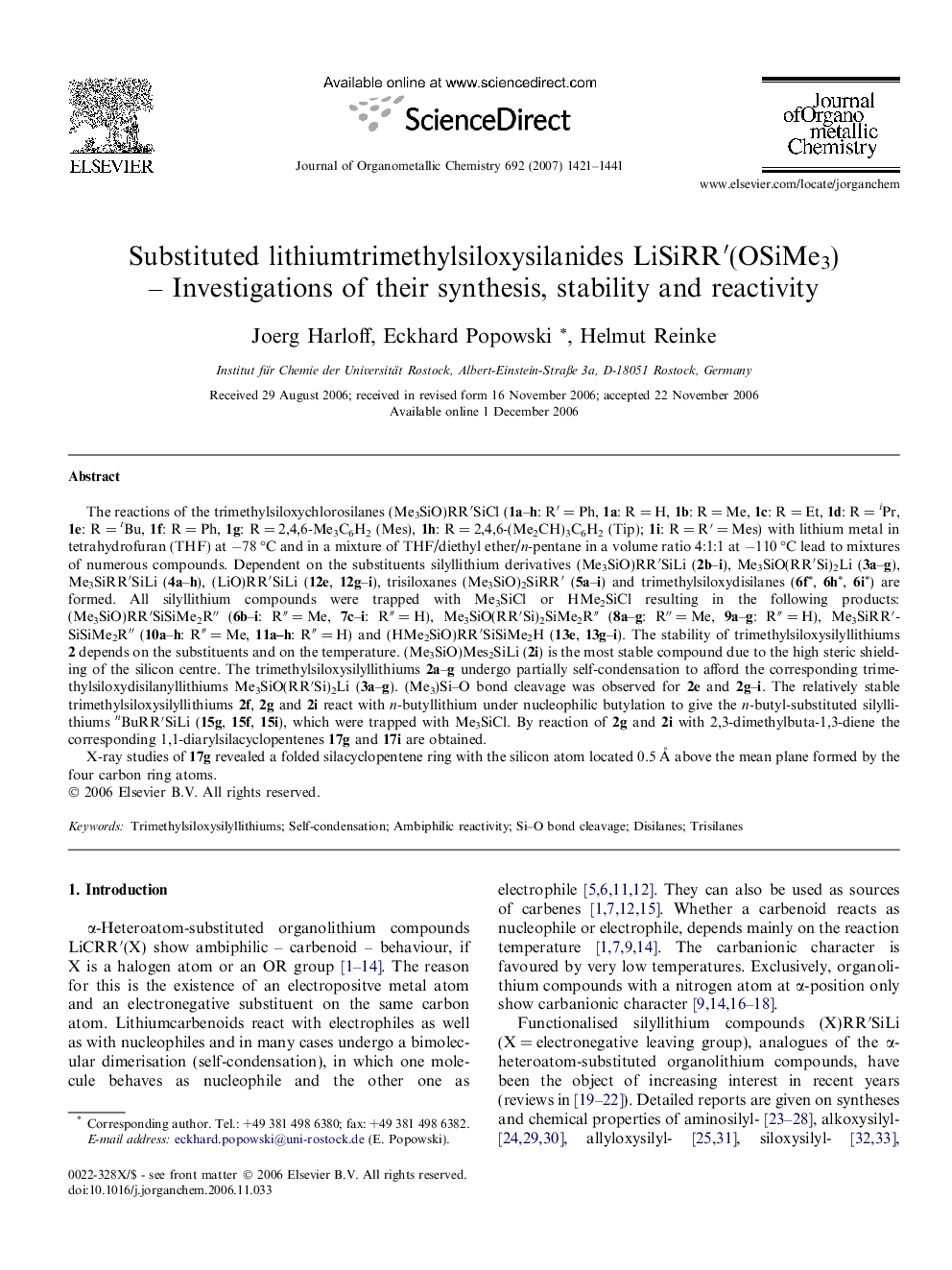| کد مقاله | کد نشریه | سال انتشار | مقاله انگلیسی | نسخه تمام متن |
|---|---|---|---|---|
| 1328259 | 977559 | 2007 | 21 صفحه PDF | دانلود رایگان |

The reactions of the trimethylsiloxychlorosilanes (Me3SiO)RR′SiCl (1a–h: R′ = Ph, 1a: R = H, 1b: R = Me, 1c: R = Et, 1d: R = iPr, 1e: R = tBu, 1f: R = Ph, 1g: R = 2,4,6-Me3C6H2 (Mes), 1h: R = 2,4,6-(Me2CH)3C6H2 (Tip); 1i: R = R′ = Mes) with lithium metal in tetrahydrofuran (THF) at −78 °C and in a mixture of THF/diethyl ether/n-pentane in a volume ratio 4:1:1 at −110 °C lead to mixtures of numerous compounds. Dependent on the substituents silyllithium derivatives (Me3SiO)RR′SiLi (2b–i), Me3SiO(RR′Si)2Li (3a–g), Me3SiRR′SiLi (4a–h), (LiO)RR′SiLi (12e, 12g–i), trisiloxanes (Me3SiO)2SiRR′ (5a–i) and trimethylsiloxydisilanes (6f∗, 6h∗, 6i∗) are formed. All silyllithium compounds were trapped with Me3SiCl or HMe2SiCl resulting in the following products: (Me3SiO)RR′SiSiMe2R″ (6b–i: R″ = Me, 7c–i: R″ = H), Me3SiO(RR′Si)2SiMe2R″ (8a–g: R″ = Me, 9a–g: R″ = H), Me3SiRR′SiSiMe2R″ (10a–h: R″ = Me, 11a–h: R″ = H) and (HMe2SiO)RR′SiSiMe2H (13e, 13g–i). The stability of trimethylsiloxysilyllithiums 2 depends on the substituents and on the temperature. (Me3SiO)Mes2SiLi (2i) is the most stable compound due to the high steric shielding of the silicon centre. The trimethylsiloxysilyllithiums 2a–g undergo partially self-condensation to afford the corresponding trimethylsiloxydisilanyllithiums Me3SiO(RR′Si)2Li (3a–g). (Me3)Si–O bond cleavage was observed for 2e and 2g–i. The relatively stable trimethylsiloxysilyllithiums 2f, 2g and 2i react with n-butyllithium under nucleophilic butylation to give the n-butyl-substituted silyllithiums nBuRR′SiLi (15g, 15f, 15i), which were trapped with Me3SiCl. By reaction of 2g and 2i with 2,3-dimethylbuta-1,3-diene the corresponding 1,1-diarylsilacyclopentenes 17g and 17i are obtained.X-ray studies of 17g revealed a folded silacyclopentene ring with the silicon atom located 0.5 Å above the mean plane formed by the four carbon ring atoms.
Chlorosilanes (Me3SiO)RR′SiCl (R/R′ = (H, Me, Et, iPr, tBu, Ph, Mes, Tip)/Ph and Mes/Mes) react with lithium metal to give Me3SiO(RR′Si)nLi (n = 1, 2), Me3SiRR′SiLi and (LiO)RR′SiLi. The stability of (Me3SiO)RR′SiLi depends on substituents and temperature. In the reaction of selected derivatives (Me3SiO)RR′SiLi with nBuLi and 2,3-dimethylbuta-1,3-diene n-butylation products and silacyclopentenes are obtained, respectively.Figure optionsDownload as PowerPoint slide
Journal: Journal of Organometallic Chemistry - Volume 692, Issue 7, 1 March 2007, Pages 1421–1441